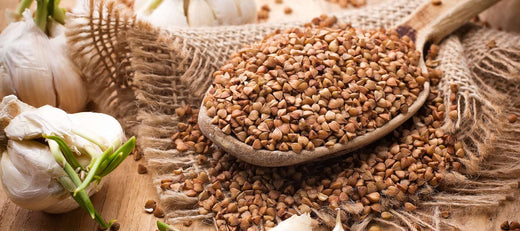If you’re looking for a versatile grain crop or a cover crop to add to your survival garden, why not consider growing buckwheat? The seeds provide a nutrient-rich and gluten-free alternative to wheat that can be used in many different ways in the kitchen. Its young leaves are also edible and can be used as a tangy salad green or even grown as microgreens. In the garden, buckwheat provides many benefits, too. It’s drought-resistant, low-maintenance, and surprisingly easy to grow, even for inexperienced gardeners.
Whole Grains without the Gluten
Despite its name, buckwheat isn’t really a type of wheat or a true grain or cereal at all. It’s considered a pseudograin, which means its seeds are used in the same way as grain even though the plant isn’t a true grass. Buckwheat is more closely related to rhubarb and sorrel. Since it’s not a true wheat, it is an ideal substitute for grains for those who are sensitive to wheat or gluten protein. Buckwheat is rich in fiber, protein, and many essential minerals and antioxidants and is an excellent source of whole-grain nutrition.
Garden Benefits

Buckwheat is an excellent choice for your survival garden, too. Once established, it’s fairly drought tolerant and grows very quickly, keeping your soil covered and suppressing weeds. Soil shouldn’t be left open as the soil biome needs roots from plants to provide nutrients, and buckwheat’s root system helps to condition the soil for better structure, drainage, and aeration. It also reduces erosion by binding the soil and preventing it from being lost to water, wind, or other forces. If used as a “green manure”, buckwheat will enrich the soil with organic matter and essential nutrients (particularly phosphorus). Buckwheat flowers attract bees and other pollinators to the garden, improving local biodiversity and aiding in the pollination and fertility of all of your garden plants.
Planting Buckwheat
Buckwheat can be planted as a food crop or a cover crop when the soil temperature is 50°F or higher. Late spring, early summer, or even fall are good times to grow this fast-growing plant. Choose a sunny location. Buckwheat isn’t fussy about soil quality and will thrive in most types of soil as long as it’s well-draining and not overly wet. Broadcast the seeds and tamp them into the soil at a depth of about ½-1 inch deep. In about a week or two, you’ll see the first signs of your buckwheat plants.
Cutting Down Buckwheat Cover Crop

If you are growing buckwheat as a cover crop, cut it down about a week after it flowers so that it doesn’t go to seed and take over your garden. Under optimal growing conditions, this can be as fast as 3-5 weeks! Cutting down your buckwheat at this time also allows you to capture the nutrients in the plant before it begins to transfer its nutrients to seeds. You can compost the plants or immediately till them back into the soil as green manure. If you’re interested in no-till techniques for soil improvement, the “chop and drop” method of simply dropping the foliage right back onto the ground works well. The plant will form a layer of mulch that will break down into compost at the soil level gradually.
Harvesting Buckwheat for Grain
More patience is required for growing buckwheat as a food crop. To harvest, you need to wait until at least three-quarters of the seeds have turned brown, around 10-12 weeks after planting. To harvest the grain, cut the plants about halfway up the stem. Allow the cut plants to dry in a warm, dry, well-ventilated area for about a week. After that, simply shake or strip the seeds from the stems.
Hulling, Milling, and Grinding Buckwheat

After you’ve harvested your seeds, buckwheat must have the tough outer hull removed. You can manually hull buckwheat with a rolling pin or a grain mill set on a very coarse setting. This is a labor-intensive process, but all of that elbow grease will pay off and you’ll be left with nutritious groats. These can be used as-is for a nutritious whole grain, or roasted for deeper flavor. Buckwheat groats can be cooked just like rice, and have a nutty flavor that pairs well with sweet and savory flavors. Common uses for buckwheat groats are salads, side dishes, or as a breakfast cereal.
If you want to make gluten-free buckwheat flour, you can grind the groats using a grain mill or even a good-quality coffee grinder in a pinch. Buckwheat flour has a unique, robust flavor and can be used for gluten-free baking, buckwheat pancakes, or even making nutritious soba noodles!
Survival Garden Superstar
Buckwheat is as versatile as it is nourishing. It’s a fast-growing, no-fuss plant that adds diversity to the ecosystem, nutrients to the soil, and food for pollinators. When grown as a food crop, it’s nutritious from the microgreen stage all the way to seed. It provides a gluten-free grain option that can be eaten by those with gluten intolerance or celiac disease. The next time you’re stumped on what to grow in a spare garden allotment, give buckwheat a try. We know you’ll love this impressive plant as much as we do!
























